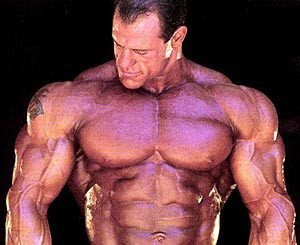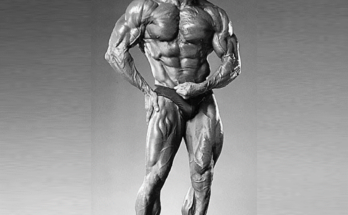 By Tom Venuto
By Tom Venuto
The primary difference between the effects of rep ranges on the adaptive response depends on whether the load affects neural factors (low reps) or metabolic factors (higher reps). When you train with low reps (1 – 5), the adaptations that make you stronger are mostly neurological: You develop an increased ability to recruit more muscle fibers, you stimulate the higher threshold fibers that are not activated with high rep, low weight sets, you decrease neuromuscular inhibition, and there is increased coordination between the muscle groups. However, with low reps, the hypertrophy (size increase) of the muscle fibers is minimal.
In other words, reps under 6 make you stronger, but they don’t necessarily make you bigger because the strength gains come from adaptations in the nervous system – the muscle fibers and other muscle cell structures do not hypertrophy (enlarge). This explains why certain athletes, powerlifters and Olympic lifters can be wicked strong but they don’t look as strong as they are.
When you train with medium reps (6-12) the adaptations are more metabolic and cellular and only moderately neurological. This is why 6-12 reps is the range most often recommended for bodybuilding and hypertrophy. You get bigger and stronger in this rep range, but your strength gains are not maximal. This explains why some bodybuilders look stronger than they are (and why they are often the brunt of jokes made by powerlifters and weight lifters; i.e. “big, weak, slow, useless muscles”, ha ha).
When you train with higher reps (13-20+), the adaptations are mostly metabolic and cellular. This rep range produces local muscular endurance, a small degree of hypertrophy in certain cellular components such as the mitochondria and the capillaries, and very little strength.
There is not a distinct line where neural adaptations end and structural/metabolic adaptations begin; rather it is a continuum, like temperature or colors of a rainbow.
For example, when you train in the 6-8 rep range, the adaptations are still somewhat neural, but also metabolic/structural: In this rep range, you get excellent strength gains and also excellent hypertrophy. In the 8-12 rep range, there is still some neural adaptation, but less than the 6-8 range and much less than the 1-5 range. The advantage of the 8-12 rep range is that you get maximal hypertrophy (this is the best rep range for pure size increases when strength is not the number one concern). You will also get stronger, of course, but not nearly to the degree as you would training with lower reps.
Rep range Percent of 1 rep max Training Effect Goal desired
1-5 reps 85-100% Neural Strength & power little hypertrophy
6-8 reps 75-85% Neural & metabolic Strength & Hypertrophy
9-12 reps 70-75% Metabolic & Neural Hypertrophy & some strength
13-20+ reps 60-70% Metabolic local endurance some hypertrophy, little strength
Now, what exactly happens inside the muscle to make it get bigger and not necessarily stronger? Quite simply, ALL the structures inside the muscle cell grow when exposed to the appropriate training stimulus.
Remember back in high school when you had to memorize those diagrams of cellular anatomy (or you would get an F in the class)? There were all kinds of organelles and cell structures such as the endoplasmic reticulum, the mitochondria, the golgi complex, ribosomes, centrioles, Lysosomes, and cytoplasm. Remember all that stuff?
If you’re anything like me, you defied your biology teacher to explain the reason why you had to memorize all that crap and what good it would do you in the “real world.” Well, now that you’re in the “real world” and you want strength and muscles, here you go:
A muscle cell has all the same cell structures as other body cells, and they all take up space. When speaking of the muscle cell, you mostly hear about the mitochondria (the cellular powerhouse where energy production takes place), the myofibrils (the actual muscle fibers themselves) and the fluid inside the cell (called cytoplasm in other body cells, or in the case of the muscle cell, its called sarcoplasm).
Myofibrillar hypertrophy is caused most effectively in the 6-8 rep range. This contributes to the most visible increases in muscle mass and cross sectional width. However, that doesn’t mean you should only train in the 6-8 rep range. If you want to make the other “stuff” in the muscle cell grow as well, you should train in all rep ranges. The mitochondria and sarcoplasm also take up a substantial amount of space in the muscle cell and they are best stimulated with high reps. High rep training can also stimulate increased capillarization in the muscle (just ask former Mr. Universe and Mr. Legs himself, Tom Platz, about the effectiveness of high rep leg training done in addition to the low and medium rep training).
In addition, there is more than one type of muscle fiber: you have slow twitch (type I) and fast twitch (type IIa and IIb). Slow twitch muscle fibers also hypertrophy from higher reps (although they have the least potential for size increases, which is why you should spend more time below 13 reps if it’s muscle mass you’re after).
So here’s the take home lesson: If you’re an athlete and your primary goal is strength and power for improved sports performance, then a good majority of your training is going to be in the 1-5 rep range. This will help make you stronger, faster and more powerful without adding muscle bulk. If you’re a bodybuilder and your primary goal is muscle mass, then the majority of your training should be done in the 6-12 rep range, but you should also do a little bit of training in the 3-5 rep range for power and strength, which will later facilitate hypertrophy (and prevent the powerlifters from making fun of you), and you should do a little bit of training in the 13-20+ rep range to facilitate the development of slow twitch muscle fiber, build mitochondrial density and increase capillarization.
Post Footer automatically generated by Add Post Footer Plugin for wordpress.
